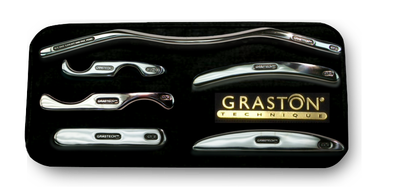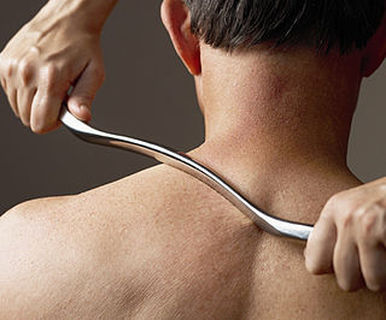Graston Soft-Tissue Tehnique
The Chiropractor at SpringWell uses Graston Soft Tissue Technique as part of regular treatment for patients with acute and chronic muscle pain and tightness, sports related injuries including meniscus tears and other ligament tears, plantar fasciitis, and more...
The body is comprised of four types of tissues, two of which are muscular and connective tissue. Muscles, along with many other things, contract and relax to help with the movement of the body at the joint. Most people understand the function and capability of muscle tissue, but it is connective tissue that seems to be commonly forgotten.
Connective tissue consists of ligaments, tendons and fascia. Fascia is a very thin layer of tissue that weaves its way around every muscle, tendon and even organs. It connects the top of your head to the tips of your toes, and is the main stabilizing structure for the human form. But fascia is not flexible like muscle, it cannot contract or relax. It is a fine network of fibers that can tear if stretched, also known as a sprain.
When an injury within the soft tissue occurs, the fascia repairs itself in a haphazard pattern, forming scar tissue. While the scar tissue itself is not painful, it does tend to limit range of motion, and the ongoing stiffness may contribute to areas of the body feeling stiff or painful. While it may not sound like a serious injury, a simple muscle strain or torn ligament can cause excruciating pain and difficulty with movement. Thus, when someone says that they feel tight or have pain with motion, they are experiencing the side effects of scar tissue build-up within the muscle.
Connective tissue consists of ligaments, tendons and fascia. Fascia is a very thin layer of tissue that weaves its way around every muscle, tendon and even organs. It connects the top of your head to the tips of your toes, and is the main stabilizing structure for the human form. But fascia is not flexible like muscle, it cannot contract or relax. It is a fine network of fibers that can tear if stretched, also known as a sprain.
When an injury within the soft tissue occurs, the fascia repairs itself in a haphazard pattern, forming scar tissue. While the scar tissue itself is not painful, it does tend to limit range of motion, and the ongoing stiffness may contribute to areas of the body feeling stiff or painful. While it may not sound like a serious injury, a simple muscle strain or torn ligament can cause excruciating pain and difficulty with movement. Thus, when someone says that they feel tight or have pain with motion, they are experiencing the side effects of scar tissue build-up within the muscle.
|
How Graston Technique Works This form of manual therapy utilizes soft tissue mobilization and incorporates the use of stainless-steel instruments. The goal of the therapy is to separate and break down the scar tissue, as well as stretch connective tissue and muscle fibers. The Graston Technique uses the instruments with a specialized form of massage that is designed to help the practitioner identify areas of restriction. The concave and convex stainless steel instruments are used to comb over and catch on injured fibrotic tissue. The procedure breaks-up the scar tissue and fibrous adhesions in the fascia and releases the underlying muscle. |
Using a cross-friction massage, which involves brushing or rubbing against the grain of the scar tissue, the practitioner re-introduces small amounts of trauma to the affected area. This temporarily causes inflammation in the area, which in turn increases the rate and amount of blood flow in and around the area. This procedure helps initiate and promote the healing process of the affected soft tissues. |
Graston Technique can be used for most acute and chronic musculo-skeletal conditions (please see list for a few common conditions). Graston Technique can also be used for muscle training, coordination and performance enhancing. There is little to no side effects from treatment, and there is no necessary downtime after the treatment. For additional information, please view the slideshow below for a comprehensive introduction to this technique.
Commonly treated conditions include:
|
|
|


